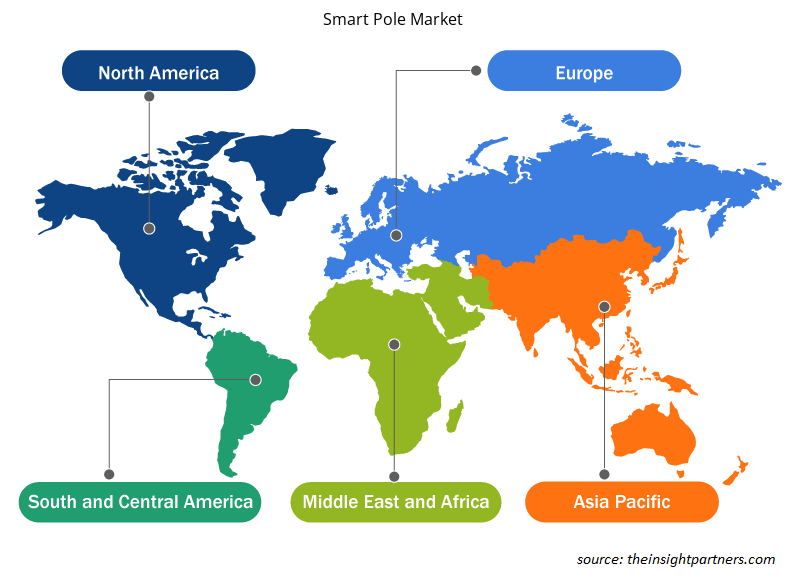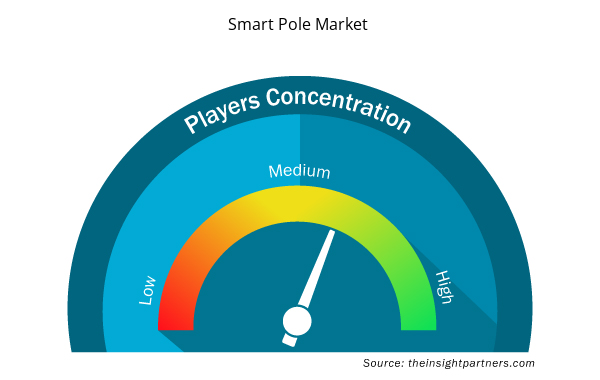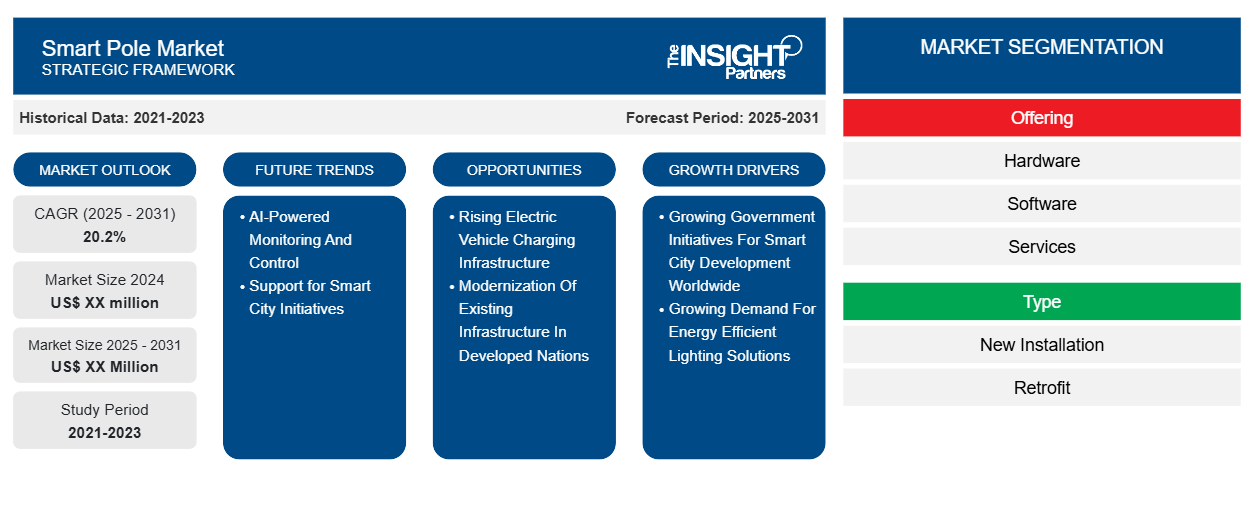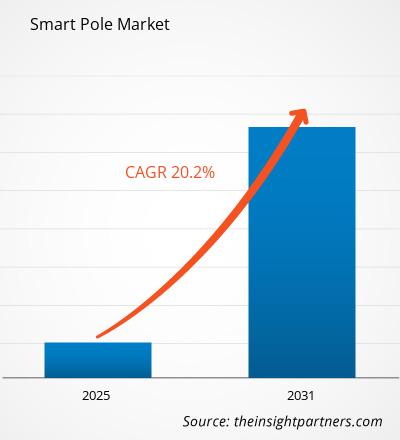Si prevede che il mercato degli Smart Pole registrerà un CAGR del 20,2% dal 2024 al 2031, con una dimensione di mercato in espansione da XX milioni di dollari nel 2024 a XX milioni di dollari entro il 2031.CAGR of 20.2% from 2024 to 2031, with a market size expanding from US$ XX million in 2024 to US$ XX Million by 2031.
Il report è segmentato per Offerta (Hardware, Software, Servizi); Tipo (Nuova Installazione, Retrofit); Applicazione (Autostrade e Strade, Luoghi Pubblici, Ferrovie e Porti, Altri). L'analisi globale è ulteriormente suddivisa a livello regionale e nei principali Paesi. Il report offre il valore in USD per l'analisi e i segmenti di cui sopra
Scopo del rapporto
Il report Smart Pole Market di The Insight Partners mira a descrivere il panorama attuale e la crescita futura, i principali fattori trainanti, le sfide e le opportunità. Ciò fornirà spunti a vari stakeholder aziendali, come:
- Fornitori/produttori di tecnologia: per comprendere le dinamiche di mercato in evoluzione e conoscere le potenziali opportunità di crescita, consentendo loro di prendere decisioni strategiche informate.
- Investitori: condurre un'analisi completa delle tendenze in merito al tasso di crescita del mercato, alle proiezioni finanziarie del mercato e alle opportunità esistenti lungo la catena del valore.
- Enti di regolamentazione: regolamentano le politiche e le attività di controllo sul mercato allo scopo di ridurre al minimo gli abusi, preservare la fiducia degli investitori e sostenere l'integrità e la stabilità del mercato.
Segmentazione del mercato dei pali intelligenti
Offerta
- Hardware
- Software
- Servizi
Tipo
- Nuova installazione
- Ristrutturare
Applicazione
- Autostrade e carreggiate
- Luoghi pubblici
- Ferrovie e porti
- Altri
Geografia
- America del Nord
- Europa
- Asia-Pacifico
- America del Sud e Centro
- Medio Oriente e Africa
Personalizza questo report in base alle tue esigenze
Riceverai la personalizzazione gratuita di qualsiasi report, comprese parti di questo report, o analisi a livello nazionale, pacchetto dati Excel, oltre a usufruire di grandi offerte e sconti per start-up e università
- Scopri le principali tendenze di mercato in questo rapporto.Questo campione GRATUITO includerà analisi di dati che spaziano dalle tendenze di mercato alle stime e alle previsioni.
Driver di crescita del mercato dei pali intelligenti
- Iniziative governative in crescita per lo sviluppo di città intelligenti in tutto il mondo: iniziative governative come lo Smart Cities Marketplace dell'Unione Europea, la Smart Cities Mission dell'India e programmi simili in Nord America e Asia-Pacifico stanno creando una domanda diretta di componenti infrastrutturali intelligenti, tra cui i pali intelligenti. I governi stanno riconoscendo sempre di più i pali intelligenti come punti di integrazione critici per molteplici servizi urbani, il che porta a mandati e incentivi per la loro distribuzione, stabilendo al contempo standard e quadri che facilitano un'adozione e un'implementazione più facili nelle città.
- Crescente domanda di soluzioni di illuminazione a risparmio energetico: l'integrazione dell'illuminazione a LED nei pali intelligenti offre notevoli risparmi energetici (fino al 50-70%) rispetto ai sistemi di illuminazione tradizionali, offrendo al contempo vantaggi aggiuntivi come capacità di oscuramento, programmazione automatica e illuminazione reattiva in base alle condizioni ambientali o al rilevamento del movimento. Questa attenzione all'efficienza energetica è in linea sia con gli obiettivi di sostenibilità ambientale sia con gli obiettivi di riduzione dei costi a lungo termine per la gestione delle infrastrutture urbane
Tendenze future del mercato dei pali intelligenti
- Monitoraggio e controllo basati sull'intelligenza artificiale: tramite sensori integrati e algoritmi di intelligenza artificiale, i pali intelligenti possono ora regolare autonomamente i livelli di illuminazione, monitorare la qualità dell'aria, rilevare incidenti di sicurezza e gestire il flusso del traffico in tempo reale. I sistemi di intelligenza artificiale possono analizzare modelli, prevedere esigenze di manutenzione, ottimizzare l'uso di energia e fornire informazioni utili ai responsabili della città, mentre le capacità di apprendimento automatico consentono al sistema di migliorare continuamente le sue prestazioni e adattarsi alle mutevoli condizioni urbane.
- Supporto per le iniziative Smart City: i pali intelligenti stanno diventando centrali nei progetti di smart city, fornendo infrastrutture essenziali per gli ecosistemi digitali urbani. Supportano varie applicazioni come illuminazione intelligente, telecamere di sorveglianza, monitoraggio della qualità dell'aria e stazioni di ricarica per veicoli elettrici (EV), migliorando la gestione della città e la qualità della vita urbana.
Opportunità di mercato dei pali intelligenti
- Crescente infrastruttura di ricarica per veicoli elettrici: la crescente opportunità di infrastrutture di ricarica per veicoli elettrici sta influenzando significativamente la crescita del mercato dei pali intelligenti, combinando le capacità di ricarica con l'infrastruttura di illuminazione stradale esistente. Questa integrazione affronta la sfida critica di installare punti di ricarica in aree urbane con spazio limitato, sfruttando al contempo le connessioni elettriche e le posizioni esistenti. I pali intelligenti con ricarica EV integrata possono fornire un comodo accesso alla ricarica in aree di parcheggio, quartieri commerciali e zone residenziali, mentre le funzionalità intelligenti consentono prezzi dinamici, monitoraggio dell'utilizzo e gestione del carico, rendendoli una soluzione interessante per le città che espandono la propria infrastruttura EV.
- Modernizzazione delle infrastrutture esistenti nelle nazioni sviluppate: la modernizzazione delle infrastrutture esistenti nelle nazioni sviluppate sta creando notevoli opportunità di crescita del mercato dei pali intelligenti, poiché le città cercano di aggiornare l'illuminazione stradale e le infrastrutture di pubblica utilità obsolete. Questa spinta alla modernizzazione è particolarmente forte in Nord America e in Europa, dove le città stanno sostituendo i tradizionali lampioni e pali di pubblica utilità con alternative intelligenti che offrono molteplici funzionalità. Il ciclo di sostituzione offre un'opportunità naturale per passare ai pali intelligenti, mentre le reti elettriche e di comunicazione esistenti possono essere sfruttate per ridurre i costi di installazione, rendendo la transizione più economicamente fattibile per i comuni.
Approfondimenti regionali sul mercato dei pali intelligenti
Le tendenze regionali e i fattori che influenzano il mercato Smart Pole durante il periodo di previsione sono stati ampiamente spiegati dagli analisti di Insight Partners. Questa sezione discute anche i segmenti e la geografia del mercato Smart Pole in Nord America, Europa, Asia Pacifico, Medio Oriente e Africa e Sud e Centro America.

- Ottieni i dati specifici regionali per il mercato Smart Pole
Ambito del rapporto di mercato Smart Pole
| Attributo del report | Dettagli |
|---|---|
| Dimensioni del mercato nel 2024 | XX milioni di dollari USA |
| Dimensioni del mercato entro il 2031 | XX milioni di dollari USA |
| CAGR globale (2025 - 2031) | 20,2% |
| Dati storici | 2021-2023 |
| Periodo di previsione | 2025-2031 |
| Segmenti coperti | Offrendo
|
| Regioni e Paesi coperti | America del Nord
|
| Leader di mercato e profili aziendali chiave |
|
Densità degli attori del mercato Smart Pole: comprendere il suo impatto sulle dinamiche aziendali
Il mercato Smart Pole Market sta crescendo rapidamente, spinto dalla crescente domanda degli utenti finali dovuta a fattori quali l'evoluzione delle preferenze dei consumatori, i progressi tecnologici e una maggiore consapevolezza dei vantaggi del prodotto. Con l'aumento della domanda, le aziende stanno ampliando le loro offerte, innovando per soddisfare le esigenze dei consumatori e capitalizzando sulle tendenze emergenti, il che alimenta ulteriormente la crescita del mercato.
La densità degli operatori di mercato si riferisce alla distribuzione di aziende o società che operano in un particolare mercato o settore. Indica quanti concorrenti (operatori di mercato) sono presenti in un dato spazio di mercato in relazione alle sue dimensioni o al valore di mercato totale.
Le principali aziende che operano nel mercato degli Smart Pole sono:
- Società per azioni Philips Lighting
- GE Lighting Co. Ltd
- Hubbell Incorporato
- Società per azioni Cree, Inc.
- Società Eaton
Disclaimer : le aziende elencate sopra non sono classificate secondo un ordine particolare.

- Ottieni una panoramica dei principali attori del mercato dei pali intelligenti
Punti di forza chiave
- Copertura completa: il rapporto affronta in modo completo l'analisi di prodotti, servizi, tipologie e utenti finali del mercato dei pali intelligenti, fornendo una panoramica olistica.
- Analisi degli esperti: il rapporto è compilato sulla base della conoscenza approfondita di esperti e analisti del settore.
- Informazioni aggiornate: il rapporto garantisce la pertinenza aziendale grazie alla copertura di informazioni recenti e tendenze nei dati.
- Opzioni di personalizzazione: questo report può essere personalizzato per soddisfare le esigenze specifiche del cliente e adattarsi in modo appropriato alle strategie aziendali.
Il rapporto di ricerca sullo Smart Pole Market può, quindi, aiutare a guidare il percorso di decodifica e comprensione dello scenario del settore e delle prospettive di crescita. Sebbene possano esserci alcune preoccupazioni valide, i vantaggi complessivi di questo rapporto tendono a superare gli svantaggi.
- Analisi storica (2 anni), anno base, previsione (7 anni) con CAGR
- Analisi PEST e SWOT
- Valore/volume delle dimensioni del mercato - Globale, regionale, nazionale
- Industria e panorama competitivo
- Set di dati Excel


- Quantitative Structure-Activity Relationship (QSAR) Market
- Visualization and 3D Rendering Software Market
- Adaptive Traffic Control System Market
- Airline Ancillary Services Market
- Hummus Market
- Digital Pathology Market
- Small Satellite Market
- Machine Condition Monitoring Market
- Mesotherapy Market
- Aesthetic Medical Devices Market

Report Coverage
Revenue forecast, Company Analysis, Industry landscape, Growth factors, and Trends

Segment Covered
This text is related
to segments covered.

Regional Scope
North America, Europe, Asia Pacific, Middle East & Africa, South & Central America

Country Scope
This text is related
to country scope.
Domande frequenti
Some of the customization options available based on the request are an additional 3-5 company profiles and country-specific analysis of 3-5 countries of your choice. Customizations are to be requested/discussed before making final order confirmation# as our team would review the same and check the feasibility
The report can be delivered in PDF/PPT format; we can also share excel dataset based on the request
Growing government initiatives for smart city development worldwide and growing demand for energy efficient lighting solutions are the major factors driving the smart pole market
AI-powered monitoring and control is anticipated to play a significant role in the global smart pole market in the coming years
The Smart Pole Market is estimated to witness a CAGR of 20.2% from 2023 to 2031
Trends and growth analysis reports related to Electronics and Semiconductor : READ MORE..
1. Philips Lighting Holding B. V.
2. GE Lighting Co. Ltd
3. Hubbell Incorporated
4. Cree, Inc.
5. Eaton Corporation
6. Acuity Brands
7. SAPA Group
8. Maven Systems Pvt. Ltd.
9. Zumtobel Group
10. Lumca Inc.
The Insight Partners performs research in 4 major stages: Data Collection & Secondary Research, Primary Research, Data Analysis and Data Triangulation & Final Review.
- Data Collection and Secondary Research:
As a market research and consulting firm operating from a decade, we have published and advised several client across the globe. First step for any study will start with an assessment of currently available data and insights from existing reports. Further, historical and current market information is collected from Investor Presentations, Annual Reports, SEC Filings, etc., and other information related to company’s performance and market positioning are gathered from Paid Databases (Factiva, Hoovers, and Reuters) and various other publications available in public domain.
Several associations trade associates, technical forums, institutes, societies and organization are accessed to gain technical as well as market related insights through their publications such as research papers, blogs and press releases related to the studies are referred to get cues about the market. Further, white papers, journals, magazines, and other news articles published in last 3 years are scrutinized and analyzed to understand the current market trends.
- Primary Research:
The primarily interview analysis comprise of data obtained from industry participants interview and answers to survey questions gathered by in-house primary team.
For primary research, interviews are conducted with industry experts/CEOs/Marketing Managers/VPs/Subject Matter Experts from both demand and supply side to get a 360-degree view of the market. The primary team conducts several interviews based on the complexity of the markets to understand the various market trends and dynamics which makes research more credible and precise.
A typical research interview fulfils the following functions:
- Provides first-hand information on the market size, market trends, growth trends, competitive landscape, and outlook
- Validates and strengthens in-house secondary research findings
- Develops the analysis team’s expertise and market understanding
Primary research involves email interactions and telephone interviews for each market, category, segment, and sub-segment across geographies. The participants who typically take part in such a process include, but are not limited to:
- Industry participants: VPs, business development managers, market intelligence managers and national sales managers
- Outside experts: Valuation experts, research analysts and key opinion leaders specializing in the electronics and semiconductor industry.
Below is the breakup of our primary respondents by company, designation, and region:

Once we receive the confirmation from primary research sources or primary respondents, we finalize the base year market estimation and forecast the data as per the macroeconomic and microeconomic factors assessed during data collection.
- Data Analysis:
Once data is validated through both secondary as well as primary respondents, we finalize the market estimations by hypothesis formulation and factor analysis at regional and country level.
- Macro-Economic Factor Analysis:
We analyse macroeconomic indicators such the gross domestic product (GDP), increase in the demand for goods and services across industries, technological advancement, regional economic growth, governmental policies, the influence of COVID-19, PEST analysis, and other aspects. This analysis aids in setting benchmarks for various nations/regions and approximating market splits. Additionally, the general trend of the aforementioned components aid in determining the market's development possibilities.
- Country Level Data:
Various factors that are especially aligned to the country are taken into account to determine the market size for a certain area and country, including the presence of vendors, such as headquarters and offices, the country's GDP, demand patterns, and industry growth. To comprehend the market dynamics for the nation, a number of growth variables, inhibitors, application areas, and current market trends are researched. The aforementioned elements aid in determining the country's overall market's growth potential.
- Company Profile:
The “Table of Contents” is formulated by listing and analyzing more than 25 - 30 companies operating in the market ecosystem across geographies. However, we profile only 10 companies as a standard practice in our syndicate reports. These 10 companies comprise leading, emerging, and regional players. Nonetheless, our analysis is not restricted to the 10 listed companies, we also analyze other companies present in the market to develop a holistic view and understand the prevailing trends. The “Company Profiles” section in the report covers key facts, business description, products & services, financial information, SWOT analysis, and key developments. The financial information presented is extracted from the annual reports and official documents of the publicly listed companies. Upon collecting the information for the sections of respective companies, we verify them via various primary sources and then compile the data in respective company profiles. The company level information helps us in deriving the base number as well as in forecasting the market size.
- Developing Base Number:
Aggregation of sales statistics (2020-2022) and macro-economic factor, and other secondary and primary research insights are utilized to arrive at base number and related market shares for 2022. The data gaps are identified in this step and relevant market data is analyzed, collected from paid primary interviews or databases. On finalizing the base year market size, forecasts are developed on the basis of macro-economic, industry and market growth factors and company level analysis.
- Data Triangulation and Final Review:
The market findings and base year market size calculations are validated from supply as well as demand side. Demand side validations are based on macro-economic factor analysis and benchmarks for respective regions and countries. In case of supply side validations, revenues of major companies are estimated (in case not available) based on industry benchmark, approximate number of employees, product portfolio, and primary interviews revenues are gathered. Further revenue from target product/service segment is assessed to avoid overshooting of market statistics. In case of heavy deviations between supply and demand side values, all thes steps are repeated to achieve synchronization.
We follow an iterative model, wherein we share our research findings with Subject Matter Experts (SME’s) and Key Opinion Leaders (KOLs) until consensus view of the market is not formulated – this model negates any drastic deviation in the opinions of experts. Only validated and universally acceptable research findings are quoted in our reports.
We have important check points that we use to validate our research findings – which we call – data triangulation, where we validate the information, we generate from secondary sources with primary interviews and then we re-validate with our internal data bases and Subject matter experts. This comprehensive model enables us to deliver high quality, reliable data in shortest possible time.


 Ottieni un campione gratuito per questo repot
Ottieni un campione gratuito per questo repot